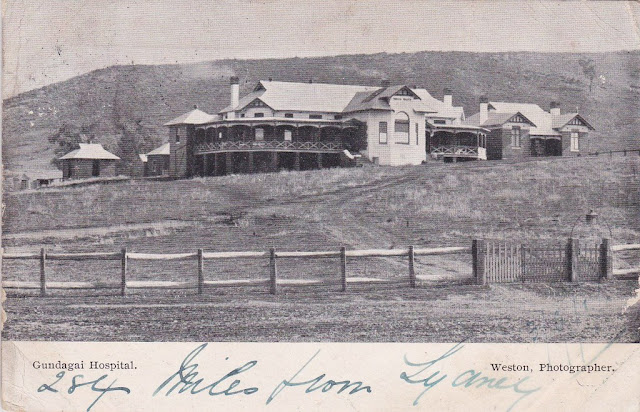Located almost midway between Sydney and Melbourne on the banks of the Murrumbidgee River, Gundagai is a small town in Southern New South Wales.
Gundagai's
built heritage can be enjoyed by engaging in a two-kilometre walk to historic points of interest. And close to the town, there are scarred trees and an Aboriginal bora ring used for ceremonies.
Wiradjuri People
The Wiradjuri people have lived over a large part of central NSW for many thousands of years.
Dreamtime and Creation stories told of ancestral spirits who created all things on earth, the land, sea, rivers, mountains and animals.
These stories would also connect people to totems, which would define Aboriginal peoples' roles and responsibilities and cultural rules and obligations. Totems were associated with animals, plants, landscape features and the weather. The river, for example, might be thought of as an ancestral creation snake.
The Dreamtime beings were law-givers, who provided the societal rules, for which any infringement could mean death. Marriage rules stopped those of the same totem marrying, which helped to prevent the inter-marriage of those closely related to each other.
R.H. Mathews (1841–1918), the ethnographer and surveyor, wrote about the initiation
ceremonies of the Wiradjuri
here
Two types of Boomerangs were used by Wiradjuri people to hunt animals. A returning boomerang would frighten animals, while a non-returning boomerang was used for hunting prey up to 100 metres away.
Stone axes were used for cutting trees, skinning animals and making implements, like coolamons (bark implement used for drinking and digging).
Man and women had clearly defined roles: women made nets and baskets by weaving grasses and reeds, and men hunted animals. Other customs and practices were also performed by men and women separately.
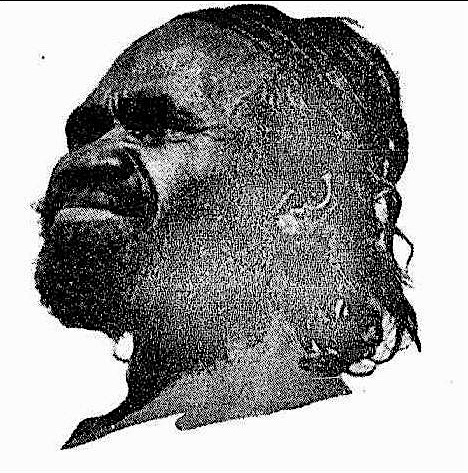 |
| Land (Sydney, NSW : 1911 - 1954) |
George Augustus Robinson noted the presence of smallpox in 1844, near Gundagai, where the Wiradjuri people were "strongly marked with smallpox".
According to the book, Guns, Germs, and Steel: The Fates of Human Societies, Aboriginal Australians were decimated by smallpox, measles, influenza and other diseases as, unlike Europeans, they had not domesticated wild animals and plants. Europeans had acquired genetic resistance to viruses carried by domestic animals.
Aboriginal Australians were also genetically isolated from the rest of humanity for about 50,000 years.
Not understanding why
so many of their people were being afflicted by illness, the Wiradjuri engaged in complex ceremonies, dances (waggana), songs and practices calling on the spirit Baiame, the "All-Father", to protect them against smallpox. Tharrawiirgal, the adversary of Baiame, they believed was responsible for illness.
There are at least nine
regional variations of the creature known as the bunyip to some Aboriginal Australians. The bunyip is a water creature/spirit who lives in swamps, billabongs, creeks and rivers. This mythical creature would kill anyone who got too close to their water source.
There are also Wiradjuri stories of ghosts, minmin (min min), lights which follow or approach people, and magic mirrii (dogs).
The river flats at Gundagai were used by the Wiradjuri people as a camping and
meeting place and hunting grounds.
Carved trees (Dendroglyphs) were used by Wiradjuri people. Lindsay Black (1941) divides carved trees into two types: for burial sites and bora grounds.
Explorers
1800s
The explorer's Hamilton Hume and William Hovell passed to the south of Gundagai in November 1824, followed not long after by settlers and sheep.
William Warby, who was born at Campbelltown, NSW, to an ex-convict father, travelled south-west, "beyond the limits of settlement" and established a run named Minghee, (MIN-gee, Aboriginal for "unwell"), North Gundagai, in 1825. (at the junction of the Murrumbidgee and Tumut Rivers).
The explorer and soldier Charles Sturt
passed through present-day Gundagai in 1829 during an exploration of the Murrumbidgee River. A cairn marks the point where Sturt crossed the river.
 |
| Captain Charles Sturt, 1853, Portrait of Captain Charles Sturt, 1795 - 1869, explorer, soldier and public servant. From the portrait by J.M. Crossland in the collection of the National Portrait Gallery, London. Another almost identical version is in the collection of the Art Gallery of South Australia. |
The brother's Peter and Henry Stuckey took up "Willie Ploma" in South Gundagai, in 1829. The weeping willows around the river at Gundagai were said to be planted by Peter Stuckey from cuttings taken by William Balcombe, the NSW Colonial Treasurer 1823-29, from trees around Napoleon's grave on St Helena.
In 1830, on the north bank of the river below Gundagai, the Thompson family first took up a station at Mickey's Corner, near Kimo Hill. The town of Gundagai was founded in 1838 on a crossing of the Murrumbidgee River.
"Mr Brodribb's second station was selected
on the spot where the important
township of Gundagai now stands. With the
assistance of one man and a few aborigines. Mr.
Brodribb washed and sheared his 1200 ewes, and
the wool was pressed by the hutkeeper with a
spade into the rough primitive box made by
themselves on the station".Squatter." Evening News (Sydney, NSW : 1869 - 1931) 24 November 1883
Many Aboriginal people
were employed from an early date by settlers in and around Gundagai.
Gundagai was gazetted as a township in 1838. A punt service at Stuckey’s Crossing was the only place to cross Murrumbidgee River at this time.
The name "Gundagai" may come from the "Gundagair" pastoral run of William Hutchinson (1838). Or the name may be Aboriginal
in origin, perhaps meaning
place of birds, or
cut with a hand-axe behind the knee (referring to the shape of the river).
In 1839 the Gundagai region experienced such a severe drought that it became a chain of waterholes. Conflict between squatters and Wiradjuri people erupted at this time, perhaps due to competition for resources.
The first sale of land occurred in December 1842, with only two purchasers buying allotments.
Robert "Bluecap" Cotterell and gang, robbed Mr Andrews, the Gundagai postmaster and innkeeper in 1843.
In 1844, the bushranger, Cashan, alias Nowlan, was being sent to Cockatoo Island, when he broke out of the lockup and travelled to Gundagai, where he stuck up Mr Nicholson's station, taking clothes, provisions, horse, saddle, and bridle.
Gundagai residents after several floods grew concerned and petitioned the NSW government to
relocate the townsite. Aboriginal people had repeatedly warned about floods
in the area.
The Old Mill, the first at Gundagai, was built in 1848 by Mr J Morley for Edward Flood and Thomas Hanley as a flour mill. The building has withstood many floods including: 1852, 1853, 1870, and 1925. Though the floods have put some holes in the walls.
By 1850, twenty houses and four hotels had been built, with another two on the southern side of the river. While a courthouse and lock-up were under construction.
Gundagai was the principal town south of Yass on the Sydney-Melbourne road in the 1850s and an important stop for travellers on their way to the Victorian goldfields.
A combined National School and teachers' residence was constructed in 1851 in weatherboard on stone foundations.
1850s
In 1850, near Tarcutta, south of Gundagai, two bushrangers held up the Royal Mail, stole the Albury and Melbourne mailbags and rode off with the mail coach's horses.
 |
| Goulburn Herald and County of Argyle Advertiser (NSW : 1848 - 1859), Saturday 25 May 1850 |
On 24 June 1852, the Murrumbidgee River flooded, burst its banks, destroying 71 buildings and killing one third
of the town’s 250 inhabitants.
Residents were clinging to the treetops. Some were swept away in the flood torrents and others died in the trees to which they clung.
"As night drew in, the unavailing cries
for assistance all around
became fearfully harassing. Crash after
crash announced the fall of some house
and the screams that followed the engulfhing
of those who clung till the water attained its
greatest height, about 11 o'clock at night, and
began to fall at 3 A.M. on Saturday. Up to
this time, about 34 houses had been washed
away, and 60 lives lost."
1852 'NEWS FROM THE INTERIOR. (From our Correspondents.) GUNDAGAI.', The Sydney Morning Herald (NSW : 1842 - 1954), 5 July
Henry Bingham, the Crown Commissioner for the Murrumbidgee District, praised the actions of Yarri, Jacky Jacky, Long Jimmy and one other Aboriginal person, rescuing more than 40 people using bark canoes, at Gundagai. This flood remains one of Australia’s worst natural disasters.
Confusingly, the heroic Yarri mentioned above, is thought to have been responsible for the death of John Baxter at Caiguna in Western Australia during
the expedition made by Edward John Eyre in 1841. The Aboriginal community at Brungle also seem to have blamed Yarri for the death of a part-Aboriginal woman, Sally McLeod, near Gundagai in 1852.
However, Yarri saved the life of John Hargreaves during the 1844 flood, and the Hargreaves family developed a friendship with Yarri and he lived on their property at Tarrabandra until his death. A nulla-nulla and shield believed to belong to Yarri, was presented to the Gundagai Historical Society by John Hargreaves' grandson Dallas. There are a number of memorials, places and structures named in Yarri's honour.
After the flood, many individuals and families were left destitute.
Major Joseph Andrews, who was really a sergeant, erected the
first home in Gudagai, and opened it as a hotel. Jacky Jacky, the Aboriginal man involved in saving people from the floods was employed by him.
After the 1852 flood, the townsite
moved away from the river flats and up to the slopes of Mt Parnassus.
Captain Cadell of Goolwa reached the town in his paddle steamer in 1853.
The inspiration for the Dog on the Tuckerbox statue can be traced to a doggerel poem, "Bullocky Bill", published anonymously by "Bowyang Yorke" in 1857.
1860s
The town lock-up needed to be rebuilt. Alexander Dawson, the colonial architect, designed the building and Charles Hardy won the tender for its construction in 1859. Further additions to the gaol occurred in 1861, and in 1863, a kitchen was built. The stone boundary wall was constructed in 1866.
Streets were named after European literary figures, such as Pope, Byron, Ovid and Virgil.
In 1861 payable gold was found at Spring Flat, near the town.
In February 1862, the bushranger Peisley was captured near Mundarlo, and by that evening, was lodged in the Gundagai Gaol. Peisley was later hanged at Bathurst.
Bushranger, John Molloy (Jack in the Boots), at one stage robbed the Australian Arms at Snake Gully, was captured in 1862 at Bethungra (West of Gundagai).
In November 1864, Ben Hall’s Gang, comprising Johnny Gilbert, Ben Hall and John Dunn, held up a mail coach between Gundagai and Jugiong and shot and killed the 32 year-old Sergeant Edmund Parry.
 |
| Australian News for Home Readers (Vic. : 1864 - 1867), Saturday 24 December 1864 |
St Johns Anglican Church was built in 1865.
The Prince Alfred Bridge was built between 1864 and 1867, to replace the punt ferry that had
linked the settlements on the north and south banks of the river. It was one of the first iron truss bridges to be built in NSW and an excellent example of early engineering.
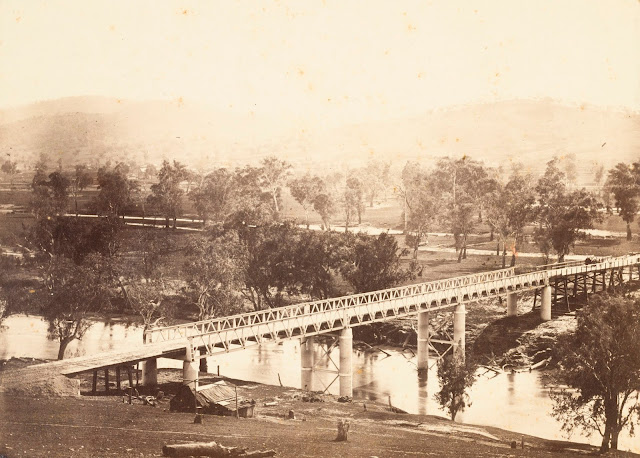 |
| Bridge at Gundagai, N.S.W., 1867 / photographer William T. Bennett, SLNSW |
1870s
Andrew George Scott, better known as the bushranger Captain Moonlite, held 30 people prisoner at a farm near Gundagai. Senior Constable Webb-Bowen was killed by Captain Moonlight, in November 1879, during the hostage incident at McGlede's farm. Moonlite was tried for murder and hanged in 1880.
Moonlite’s final wish was to be buried near his two friends in the Gundagai cemetery:
"My dying wish is to be buried beside my beloved James Nesbitt, the man with whom I was united by every tie which could bind human friendship, we were one in hopes, in heart and soul and this unity lasted until he died in my arms". His request was not granted by the authorities
of the time, but in January 1995, his
remains were exhumed from Rookwood Cemetery
in Sydney and reinterred at Gundagai, next to Nesbitt's grave.
(Nesbitt was fatally shot during a hold-up near Gundagai in 1879)
 |
| DESPERATE ENCOUNTER WITH BUSHRANGERS AT M'GLEDE'S FARM, NEAR GUNDAGAI. Illustrated Sydney News and New South Wales Agriculturalist and Grazier (NSW : 1872 - 1881), Saturday 29 November 1879 |
The steamer
Platypus, built for service on the Murrumbidgee, made several trips to Gundagai from Wagga Wagga durring 1879.
1880s
Yarri was buried in the Gundagai cemetery in 1880.
Asbestos was being mined between 1880 and 1921 at the Jones Creek workings, northwest of Gundagai.
In 1880, bushrangers held up the Chinese Camp at Gundagai.
St. Patrick's Catholic
Church built 1885.
Gundagai Railway Station opened in 1886.
Brungle Mission Station was established in 1888 by the Aborigines Protection Board.
 |
| Ida Pearce standing by a bark hut at Reno goldfields, Gundagai, New South Wales [picture] / Charles Gabriel, between 1887 and 1927 |
 |
Buying rabbits from the "Rabbito", Sheridan Street, Gundagai, New South Wales, 1887.
SRNSW |
 |
| Two women at Gundagai railway station [picture] / Charles Gabriel, between 1887 and 1927 |
1890s
A second gold rush begins in 1894.
 |
| Murrumbidgee Blacks- corroboree party, NSW, Weekly Times (Melbourne, Vic. : 1869 - 1954), Saturday 24 April 1897 |
The railway line from Gundagai to Tumut began in 1899, requiring a railway viaduct over the Murrumbidgee and the river flats. This opened in 1902.
1900s
 |
| "The railway station at Gundagai, New South Wales - early 1900s" byAussie~mobs is marked with CC PDM 1.0 |
 |
| Mr George Rice, half-owner of the fabulously rich gold mine at Long Flat, near Gundagai, the recent discoveries in which have caused a great sensation in local mining circles. Mr. Rice is here seen with a dish of wonderfully rich specimens; the dish contains over £1000 worth of gold, just as it was taken from the mine. Sydney Mail and New South Wales Advertiser (NSW : 1871 - 1912), Saturday 1 September 1900 |
Herbert Hoover (later president of the US) was a mining engineer at the Prince of Wales mine, Gundagai, around 1900.
The Niagara Cafe cafe
was established in 1902 by a Kytherian Greek, Strati Notara, and then the Castrission family installed the Art Deco interior and exterior in 1938.
Dr Charles Louis Gabriel was Gundagai's doctor in the late 1800s and early 1900s. He fought for a hospital for the town, which opened in 1904 in Otway Street. Between 1899 and 1900, Dr Gabriel also took many photos of the town.
 |
| 1. Mail morning at Cauvarel's Royal Hotel, Gundagai, NSW, 2. Gundagai Hospital and Church of England, NSW, Sydney Mail and New South Wales Advertiser (NSW : 1871 - 1912), Wednesday 19 November 1902 |
 |
| A BUSY MORNING AT GUNDAGAI RAILWAY STATION. Sydney Mail and New South Wales Advertiser (NSW : 1871 - 1912), Wednesday 19 November 1902 |
 |
| A store in Sheridan Street, Gundagai, NSW, Sydney Mail and New South Wales Advertiser (NSW : 1871 - 1912), Wednesday 19 November 1902 |
 |
| R. E. JONES'S GENERAL STORE, SHERIDAN-STREET. Gundagai, NSW, Sydney Mail and New South Wales Advertiser (NSW : 1871 - 1912), Wednesday 19 November 1902 |
 |
| ELLIOTT AND GROTH'S RICH FIND AT GUNDAGAI, NSW, Sydney Mail and New South Wales Advertiser (NSW : 1871 - 1912), Wednesday 22 April 1903 |
 |
| Manchester Unity Oddfellows, delegates conference at Gundagai, NSW, Australian Town and Country Journal (Sydney, NSW : 1870 - 1919), Wednesday 20 January 1904 |
 |
| Nurse outside new hospital, Gundagai, New South Wales, ca. 1904 [picture] / Charles Gabriel |
 |
| In front of Gresham's Hotel, Sheridan Street, during the Dunlop reliability trial, Gundagai, New South Wales, 1905 |
 |
| Jimmy McKinney and P.J. O'Donnell in the first car in Gundagai in Sheridan street, Gundagai, New South Wales, 1905-1927 |
In 1909 Gundagai obtained a mains water system.
 |
| The Long Tunnel Mine, Gundagai, NSW, Australian Town and Country Journal (Sydney, NSW : 1870 - 1919), Wednesday 29 March 1911 |
 |
| The Long Tunnel Mine, Gundagai, NSW, rock crusher or "dolly pot", Australian Town and Country Journal (Sydney, NSW : 1870 - 1919), Wednesday 29 March 1911 |
Sydney-Melbourne road (Great South Road) is declared a main road in 1914.
WWI
 |
| Henry Guildford “Harry” Bale (1891-1915). Landed at Gallipoli on Anzac Day as part of the 8th Battalion. He was killed 4 months later on the 27 August the day after his 24th Birthday. Sydney Mail (NSW : 1912 - 1938), Wednesday 13 October 1915, |
 |
| The Seventh Light Horse Regiment of World War 1, Gundagai, New South Wales, ca. 1918 [picture] / Charles Gabriel |
 |
| Wirth's circus comes to town, Sheridan Street, Gundagai, New South Wales, 1887-1927 (Gabriel, Charles Louis) |
 |
| Group of women at Fontenoy, Gundagai, New South Wales, between 1912 and 1927, by Gabriel, Charles Louis, NLAUST |
 |
| Dray with poles in front of the Post Office, Gundagai, New South Wales, 1887-1927 |
"At a recent meeting of the New South Wales Board for
the Protection of Aborigines, it was reported that James
Williams, a full-blooded aboriginal lad, who had received
his education at Brungle Station, had won three first prizes
and one special for handwriting at the Gundagai show, the
competition being open to all comers in the Gundagai
Tumut district."Sydney Mail (NSW : 1912 - 1938) 11 July 1917
1920s
A poem by Jack Moses referenced the Bowyang Yorke poem and the Dog on the Tuckerbox was published in the 1920s.
"Along the Road to Gundagai" is an Australian folk song written by Jack O'Hagan in 1922 and was first recorded by Peter Dawson in 1924. However, O'Hagan first visited Gundagai in 1956.
 |
| Star Hotel, Gundagai, NSW, in 1924 |
 |
| The 1925 Flood from the top of Sheridan St overlooking Prince Alfred Bridge, the rail viaduct and the old flour mill. Gundagai, NSW |
 |
| Local graziers, Jabez Nicholls, Charlie Mudear, saddler and Sam Nicholls dressed as swaggies in front of Ryans, Gundagai, New South Wales [picture] / Charles Gabriel, between 1887 and 1927 |
The old Gundagai Flour Mill in Sheridan Lane was also known as "The Sundowners" because of the swaggies
who camped there each night.
 |
| THOUGH HE HAS SEEN 66 SUMMERS this " Murray River" sundowner, thinks nothing of covering 30 miles in a day. His bluey is carried on an improvised wheelbarrow. Daily Telegraph (Sydney, NSW : 1883 - 1930), Thursday 9 February 1928 |
 |
| ELEVEN REASONS why swimming can be indulged in with- perfect safety at Gundagai South.— The life-saving team. Daily Telegraph (Sydney, NSW : 1883 - 1930), Thursday 9 February 1928 |
A dog monument was first erected at a site nine miles from Gundagai in 1926.
Gundagai stonemason Frank Rusconi suggested a memorial using the legend of the Dog on the Tuckerbox in 1928.
The Gundagai Theatre of 1928 was built in Art Deco style, as is the Criterion Hotel up the street.
The foundation stone of the Gundagai Cenotaph was laid on 24 May 1928.
 |
| The fine memorial erected at Gundagai in honour of the men who enlisted from that district for the Great War was unveiled by Major-General C. P. Cox on November 10. Sydney Mail (NSW : 1912 - 1938), Wednesday 21 November 1928 |
 |
| Sheridan Street, Gundagai, New South Wales, 1900-1927 (Charles Gabriel) |
 |
- Horse & sulky in front of Criterion Hotel, Sheridan Street, Gundagai, New South Wales [picture] / Charles Gabriel, between 1887 and 1927
|
1930s
The court house burned down in the 1930s but was faithfully re-built.
The Dog on the Tuckerbox monument was erected in 1932.
The Gundagai Avenue of Honour was established 1930s to commemorate WW1.
 |
The Prime Minister (Mr. Lyons) unveiling the memorial to the pioneers on the camping ground
near Gundagai on Monday, Sydney Morning Herald (NSW : 1842 - 1954), Wednesday 30 November 1932 |
 |
| Cootamundra Herald (NSW : 1877 - 1954), Thursday 16 July 1936 |
 |
| The Dog on the Tuckerbox, Gundagai, NSW, Sydney Mail (NSW : 1912 - 1938), Wednesday 10 August 1938 |
 |
| Sydney Mail (NSW : 1912 - 1938), Wednesday 10 August 1938 |
 |
| Mr. J. Rusconi, of Gundagai, photographed with his masterpiece in marble, which took 28 years to build. Twenty kinds of Australian marble have been used. Mr. Rusconi also built the "Dog on the Tuckerbox" monument near Gundagai. Telegraph (Brisbane, Qld. : 1872 - 1947), Tuesday 19 September 1939 |
1940s and WWI
 |
| The first trainees in the N.S.W. Women's Land Army, under the auspices of the Women's Australian National Services, are in camp at Billabong, Gundagai, the station property of, Mr, and Mrs. J. W. C, Beveridge. Sydney Morning Herald (NSW : 1842 - 1954), Tuesday 2 July 1940 |
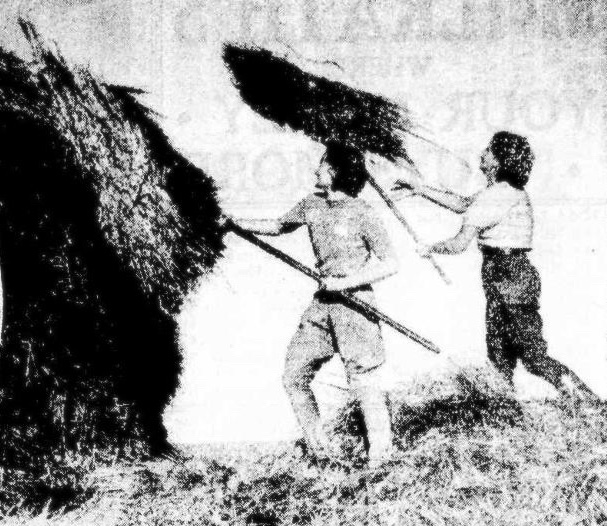 |
| Sydney Morning Herald (NSW : 1842 - 1954), Thursday 27 June 1940 |
The Niagara Café in 1942 provided a midnight meal for Australian Prime Minister John Curtin.
 |
| Weekly Times (Melbourne, Vic. : 1869 - 1954), Wednesday 28 March 1945 |
 |
Gundagai branch of the Red Cross has raised £9068 Mesdames J. 0. Robertson (Treas.), R. Long, C. Johns, J. Howard (V.P.) R. Beatty <V.P.>, T Hamilton P. turner (V.P.),H Scott, O. Palmer (Sec. ), A Hunt,
' Snr (Patroness). R. W. Hitchins (V.P.), J. Robinson (Pres.).Weekly Times (Melbourne, Vic. : 1869 - 1954), Wednesday 28 March 1945 |
1950s
 |
| Farmer and Settler (Sydney, NSW : 1906 - 1955), Friday 26 March 1954 |
1970s
Gundagai Gaol closed in the 1970s.
The Prince Alfred Bridge closed to traffic in 1976.
1980s
The railway line closed in 1984.
The famous two-day Snake Gully Cup racing carnival in November takes its name from the famous radio show of the 1950s, "Dad And Dave".
1990s
A wooden bridge that crossed Morleys Creek was burned down by Gundagai Shire Council in the 1990s.
2000s
A bronze sculpture of Yarri and Jacky Jacky with a canoe was unveiled in Gundagai in 2017.
There are 65 gazetted historic mine sites around Gundagai.
Gundagai has four bridges spanning the Murrumbidgee flats: the historic Prince Alfred Bridge, the timber Railway Bridge, and the dual Sheahan bridges of the Hume Highway.
Around Gundagai
 |
| The former Gundagai Methodist Church building, Gundagai, NSW, built 1930 |
 |
| The Gundagai, NSW, train station was officially opened on 21 July 1886 |
 |
| Rusconi's house in Gundagai, NSW, "Araluen" on Sheridan Street near the cenotaph |
 |
| The Old Mill, Gundagai, NSW, was built in 1848 by Mr J Morley for Flood and Hanley as a flour mill |
 |
| Gundagai Theatre, NSW, was built in 1928 and had 524 seats |
 |
| 114 Sheridan St, Gundagai, NSW |
 |
| Court House, Gundagai, NSW |
 |
| 116 Sheridan St, Gundagai, NSW, "Surrey", built c. 1880 by Billie Payne, a Cobb & Co. coach driver |
 |
| Annual Tractor Pull, Gundagai, NSW |
 |
| A bronze sculpture of Yarri and Jacky Jacky with a canoe was unveiled in Gundagai, NSW, in 2017 |
 |
| Main Street of Gundagai, NSW |
 |
| Gundagai, NSW |
 |
| Lotts Family Hotel/ The Family Hotel. Built in 1858. Opened as Fry's Hotel. Later was the booking office for Cobb and Co coaches, Gundagai, NSW |
 |
| Anzac Day, Gundagai, NSW. St Patricks Catholic School in Gundagai, NSW, next to the Catholic Church and the convent |
 |
| Buildings at Gundagai, NSW |
 |
| The Criterion Hotel, Sheridan Street, , Gundagai, New South Wales |
 |
| Niagara Cafe in Gundagai, New South Wales, established 1904 |
 |
| Timber viaducts, showing early engineering solutions to crossing a major flood plain, Gundagai, NSW |
 |
| Gundagai Uniting Church building, NSW, was originally erected for the Presbyterian church in 1901 |
 |
| The St John's Anglican Church Gundagai was opened in 1867, NSW |
 |
| Sheridan Street, Gundagai, NSW |
 |
| Gundagai Museum, NSW. Alexander Dawson, the colonial architect, designed the building and Charles Hardy won the tender for its construction in 1859 |
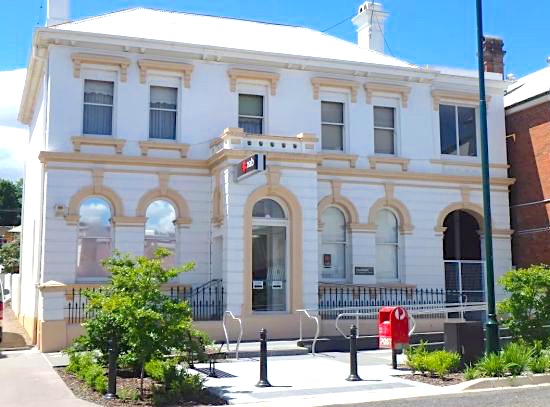 |
| National Australia Bank - Gundagai, New South Wales. Built 1887 |
 |
| "Memories, Gundagai Railway Station, New South Wales" by crissouli is licensed under CC BY 2.0 |
 |
| Post Office - Gundagai, New South Wales. Built 1880 |
 |
| Gundagai Bakehouse, NSW, established 1864 |
 |
| The former Gresham hotel, built 1853, Gundagai, NSW |
Things To Do and Places To Go
Gundagai's Architectural Heritage Walk
Old Gundagai Gaol
The Wiradyuri and Other Languages of New South Wales by R. H. Mathews
NOTES ON THE ABORIGINES OF NEW SOUTH WALES (1907)
















